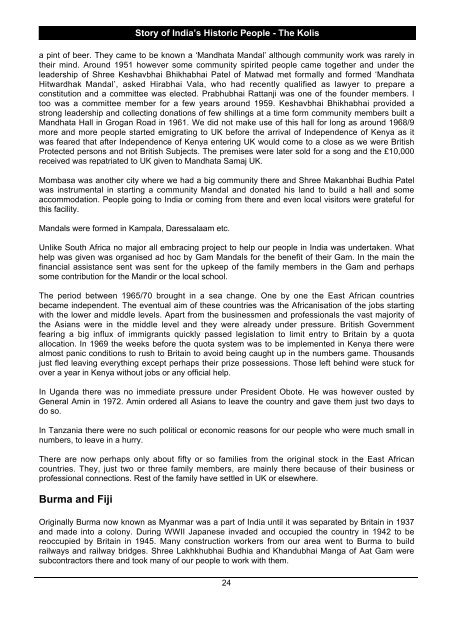THE ASSOCIATION OF MANDHATA SAMAJ UK - Mandhata Global
THE ASSOCIATION OF MANDHATA SAMAJ UK - Mandhata Global
THE ASSOCIATION OF MANDHATA SAMAJ UK - Mandhata Global
Create successful ePaper yourself
Turn your PDF publications into a flip-book with our unique Google optimized e-Paper software.
Story of India’s Historic People - The Kolis<br />
a pint of beer. They came to be known a ‘<strong>Mandhata</strong> Mandal’ although community work was rarely in<br />
their mind. Around 1951 however some community spirited people came together and under the<br />
leadership of Shree Keshavbhai Bhikhabhai Patel of Matwad met formally and formed ‘<strong>Mandhata</strong><br />
Hitwardhak Mandal’, asked Hirabhai Vala, who had recently qualified as lawyer to prepare a<br />
constitution and a committee was elected. Prabhubhai Rattanji was one of the founder members. I<br />
too was a committee member for a few years around 1959. Keshavbhai Bhikhabhai provided a<br />
strong leadership and collecting donations of few shillings at a time form community members built a<br />
<strong>Mandhata</strong> Hall in Grogan Road in 1961. We did not make use of this hall for long as around 1968/9<br />
more and more people started emigrating to <strong>UK</strong> before the arrival of Independence of Kenya as it<br />
was feared that after Independence of Kenya entering <strong>UK</strong> would come to a close as we were British<br />
Protected persons and not British Subjects. The premises were later sold for a song and the £10,000<br />
received was repatriated to <strong>UK</strong> given to <strong>Mandhata</strong> Samaj <strong>UK</strong>.<br />
Mombasa was another city where we had a big community there and Shree Makanbhai Budhia Patel<br />
was instrumental in starting a community Mandal and donated his land to build a hall and some<br />
accommodation. People going to India or coming from there and even local visitors were grateful for<br />
this facility.<br />
Mandals were formed in Kampala, Daressalaam etc.<br />
Unlike South Africa no major all embracing project to help our people in India was undertaken. What<br />
help was given was organised ad hoc by Gam Mandals for the benefit of their Gam. In the main the<br />
financial assistance sent was sent for the upkeep of the family members in the Gam and perhaps<br />
some contribution for the Mandir or the local school.<br />
The period between 1965/70 brought in a sea change. One by one the East African countries<br />
became independent. The eventual aim of these countries was the Africanisation of the jobs starting<br />
with the lower and middle levels. Apart from the businessmen and professionals the vast majority of<br />
the Asians were in the middle level and they were already under pressure. British Government<br />
fearing a big influx of immigrants quickly passed legislation to limit entry to Britain by a quota<br />
allocation. In 1969 the weeks before the quota system was to be implemented in Kenya there were<br />
almost panic conditions to rush to Britain to avoid being caught up in the numbers game. Thousands<br />
just fled leaving everything except perhaps their prize possessions. Those left behind were stuck for<br />
over a year in Kenya without jobs or any official help.<br />
In Uganda there was no immediate pressure under President Obote. He was however ousted by<br />
General Amin in 1972. Amin ordered all Asians to leave the country and gave them just two days to<br />
do so.<br />
In Tanzania there were no such political or economic reasons for our people who were much small in<br />
numbers, to leave in a hurry.<br />
There are now perhaps only about fifty or so families from the original stock in the East African<br />
countries. They, just two or three family members, are mainly there because of their business or<br />
professional connections. Rest of the family have settled in <strong>UK</strong> or elsewhere.<br />
Burma and Fiji<br />
Originally Burma now known as Myanmar was a part of India until it was separated by Britain in 1937<br />
and made into a colony. During WWII Japanese invaded and occupied the country in 1942 to be<br />
reoccupied by Britain in 1945. Many construction workers from our area went to Burma to build<br />
railways and railway bridges. Shree Lakhkhubhai Budhia and Khandubhai Manga of Aat Gam were<br />
subcontractors there and took many of our people to work with them.<br />
24

















